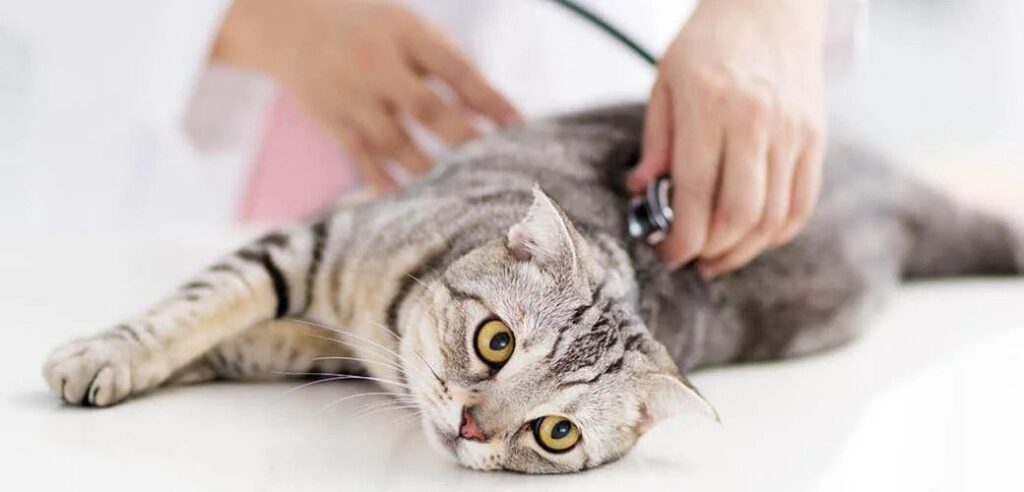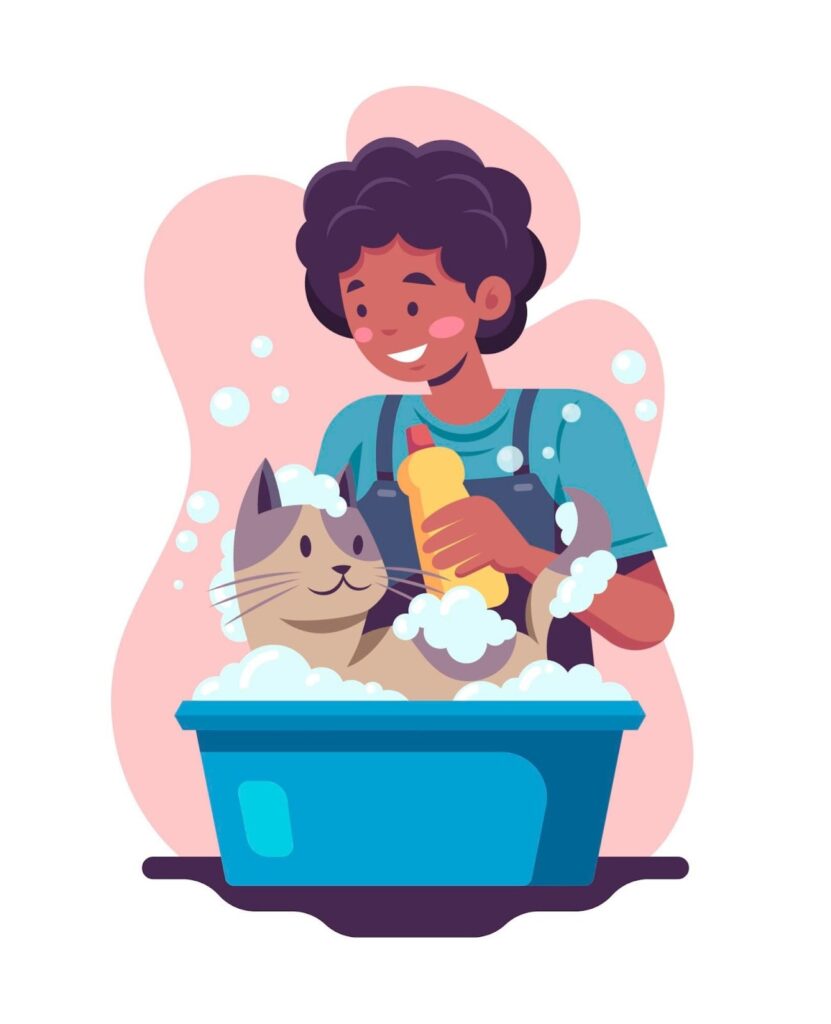Just like the other day, I was petting my cat snowy and noticed something unusual. Instead of her usual smooth and silky fur, I felt lumps and bumps scattered across her coat.
Snowy spends a few hours a day grooming to keep her fur perfect and clean. So, when I suddenly feel these clumps, I wonder “Why has my cat’s fur gone lumpy?”
After doing some research I found the causes and how to prevent it. Keep reading as I’m going to share all of my findings as well as some effective remedies that will help you to restore your cat’s coat to its former glory just like mine .
Why Does My Cat Have Bumpy Fur?
Cat fur, the epitome of elegance and softness, can sometimes take an unexpected turn, leaving your feline friend’s coat looking less than perfect. Several reasons can contribute to your cat’s fur developing a bumpy texture.

Lack of Proper Grooming
Cats produce natural oils in their skin that help keep their fur healthy and shiny. However, if they do not groom themselves regularly, these oils can accumulate and form lumps or clumps in their hair.
This can also happen if your cat has long or thick fur that is difficult to maintain.
Matting and Tangles
Sometimes, your cat’s fur may become matted or tangled due to various factors, such as humidity, static electricity, shedding, or rubbing against objects.
Matting and tangles can cause your cat’s fur to form lumps or bumps that are hard to remove. They can also cause discomfort, pain, or skin irritation to your cat.
Underlying Health Conditions
Sometimes, bumpy fur could be like a signal from your cat’s body that something’s not right inside.
Skin Infections and Allergies
Cats can get skin infection or an allergy that causes inflammation, redness, itching, or swelling of their skin, resulting in scabs, crusts, or pus-filled bumps on their skin and fur, also bald spots above eyes
Hormonal Imbalances
They may have a hormonal imbalance that affects their hair growth cycle, leading to abnormal hair loss or growth, which can cause lumps or bumps in their fur.
Parasitic Infestations
Another reason can be tiny bug problems. Parasitic infestation can cause itching, irritation, inflammation, and infection of their skin and hair.
So, if your cat gets fleas and mites, these bugs can make them scratch a lot, and this scratching can create little bumps on the skin.
Watch here to learn more about why your cat’s fur suddenly has a different texture, whether Is it for oil or dandruff.
How Does the Environment Affect My Cat’s Fur?
Believe it or not, the environment your cat lives in can have a big impact on how their fur looks and feels. Let’s break it down into simple bits-
Dietary Imbalances: Impact on Fur Quality
Just like how eating healthy foods is good for us, it’s good for cats too. Healthy diet plays a crucial role in maintaining their fur quality and health.
It helps produce healthy skin and hair cells, as well as natural oils that keep their fur shiny and smooth.
However, if your cat has a dietary imbalance, such as a deficiency or excess of certain nutrients, it can affect their fur quality and cause problems such as dryness, dullness, brittleness, or hair loss.
Stress and Its Effect on Cat Fur
Have you ever felt stressed? Well, cats can feel stressed too, and it can mess up their fur.
Stress is a common cause of overgrooming in cats, which is a behavior where cats lick or chew their fur to cope with anxiety, fear, boredom, or frustration.
Overgrooming can result in hair loss, matting, or clumping of your cat’s fur, as well as skin irritation or infection.
Exposure to Irritants: Household and Environmental Factors
Sometimes, there are things in our homes or the places where cats play that can make their fur unhappy. These things can be like tiny troublemakers.
For example, cleaning products, detergents, perfumes, smoke, pollen, dust, mold, or chemicals cause irritants, make them scratch or lick their fur. This not only turns a cat’s fur lumpy but also causes sneezing, coughing, wheezing, or vomiting.
What Grooming Practices Can Improve My Cat’s Fur?

Giving your cat’s fur some extra care can make a big difference in how it looks and feels. Here are some simple steps that can help your cat’s fur shine-
Choosing the Right Stuff: Grooming Products
When choosing grooming products, it is important to consider your cat’s fur type and length.
Short-haired cats need different grooming products than long-haired cats. For instance, a slicker brush is a good choice for long-haired cats, while a pin brush is a good choice for short-haired cats.
Regular Brushing is Like Magic for Fur
Brushing your cat’s fur regularly helps to remove loose hair, dirt, and mats, and distributes the natural oils in your cat’s fur to keep it healthy and shiny.
You should brush your cat’s fur at least once a day, but more often if they have long hair. Start brushing your cat’s hair at the head and work your way down the body.
Be gentle and avoid pulling on the hair. You can also remove mats from cat’s hair safely and easily by hand.
Baths Can Be Fun Too!
Sometimes, a good and warm bath is just what your cat needs. But bathing too often can dry out their skin and fur. Try to bathe your cat occasionally to remove dirt, dander, and parasites. [also read how to get rid of fleas on long haired cats]
After that be sure to rinse the soap or shampoo thoroughly and dry them completely. You can use a towel or a hair dryer on the cool setting to dry them out.
Food and Drink: The Inside-Out Secret
A healthy diet and plenty of water can do wonders for a cat’s coat. Make sure to feed your cat a diet that is high in protein and fatty acids, and they have plenty of fresh water to drink.
Good food gives their fur the nutrients it needs to be soft and strong. Hydration keeps their skin happy and their fur less likely to get dry and bumpy.
Keep Calm and Fur On: No Stress Allowed
Stress can also affect the health of your cat’s fur. Provide your cat with a comfortable and stress-free environment, and keep it clean and free of clutter.
Make sure their living space is calm and cozy. Spend time playing with them and giving them love—it helps their fur and their happiness.
When Should I Consult a Veterinarian About My Cat’s Fur?

Your cat’s fur is not only a part of their beauty, but also a reflection of their health.
So, knowing when to involve a veterinarian in your cat’s bumpy fur situation is important for their well-being. Let’s understand when it’s time to seek their help:
Identifying Red Flags: When Lumps Might Mean Trouble
Not all lumps are harmless, and some might be signs of a more serious issue. Keep an eye out for spotting these warning signs-
Persistent Lumps and Changes in Behavior
If your cat’s lumps do not go away after a few days or weeks, or if they get bigger or more numerous, it may be a sign of a tumor, cyst, abscess, or other growth that needs to be removed or treated.
Scratching and Irritation
If your cat is scratching or licking their fur excessively due to allergies or dermatitis, and showing any signs of redness, swelling, scabs, crusts, pus, or blood, that’s a red flag for their coat.
Sudden hair loss
If your cat suddenly loses hair not because of excessive licking or overgrooming, it could be a sign of a medical condition, such as hyperthyroidism or ringworm.
Changes in fur color or texture
Finally if you notice any changes in your cat’s fur or overall coat, this might indicate texture, it could be a sign of a medical condition, such as nutritional deficiency or a skin infection.
Vet to the Rescue: Why Professional Help Matters
When things seem more than just a small hiccup, it’s time to get a vet’s expert opinion. Veterinarians are like doctors for animals—they have the knowledge to figure out what’s going on with your cat’s fur. Sometimes, what seems small to us might be a bigger deal for our furry friends.
Getting the Right Treatment and Help
If the vet finds something not right, they can suggest the right treatment. It might involve a change in diet, medicine or special care to fix the problem. Vets know what’s best, and their help can get your cat back to having smooth and healthy fur.
Are There Home Remedies for Smoother Cat Fur?
If you’re looking to give your cat’s fur some extra love at home, there are a few simple remedies you can try.
Proper Nutrition and Supplements
Make sure to feed your cat a diet that is high in protein(e.g., fish, chicken, turkey, egg) and omega-3 fatty acids (e.g., flaxseed oil, chia seeds).
You can also add supplements to your cat’s diet, such as fish oil or biotin to improve the health of their coat.
Coconut Oil for Topical Application
Coconut oil isn’t just good for humans—it can benefit your cat’s fur too! A small amount of coconut oil, gently applied to your cat’s fur, can help moisturize and make it smoother.
But remember, a little goes a long way, and be cautious that your cat doesn’t ingest too much if they groom it off, as well as too much can be greasy.
Using Cat-Friendly Shampoos
Using cat-friendly shampoos that are specifically designed for cats. Some good options for shampoos include:
- Hypoallergenic shampoos: These shampoos are designed for cats with sensitive skin.
- Deshedding shampoos: These shampoos help to remove loose hair.
- Medicated shampoos: These shampoos can be used to treat skin conditions, such as allergies or dermatitis.

Keep in mind that these can help improve fur quality but before using them consult a veterinarian and take their approval or suggestion.
How Can I Keep Healthy and Shiny Fur in My Cat?
Maintaining your cat’s fur health goes beyond just grooming. Creating a wholesome environment and staying on top of their well-being can work wonders for their fur.
A Serene Haven: Reducing Stress Factors
As we said, high stress levels can affect their fur quality. Create a calm and soothing environment at home. Provide cozy spots for them to rest, engaging toys for playtime, and quiet corners for relaxation.
Minimizing sudden loud noises and changes in routine can help keep their stress levels in check.
The Power of Regular Check-ups
Regular visits to the veterinarian are like health check-ups for your cat. Even if your cat seems perfectly fine, these visits help catch any issues early on.
The vet can check for signs of illness that can not only affect their fur but also overall health. They also advise on diet, grooming, and overall well-being.
End of Lumpy Fur
As you take care of your cat’s fur, remember that it’s a journey of love and care. Your furry companion’s well-being is reflected in the condition of their coat. So, by following the tips in this article, you can help your cat have a beautiful, healthy coat of fur.
I hope this article was helpful. Share these insights with other cat lovers and comment below to share your opinion.

